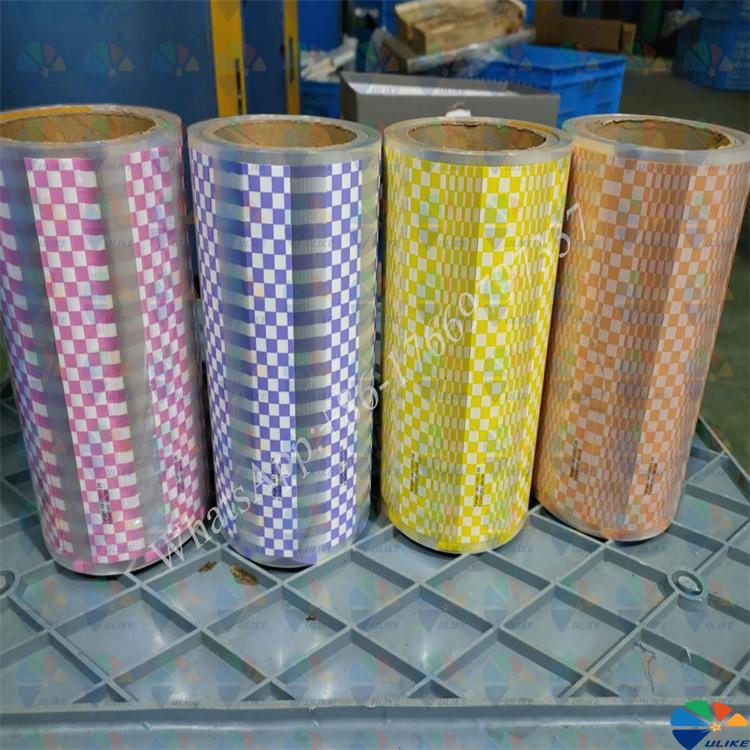Laser thermal transfer film
Laser thermal transfer film
1. What is laser thermal transfer film
Laser thermal transfer film is a series with the longest production process and the most special process in the entire thermal transfer film group. It is precisely because of the long process and special process that laser thermal transfer film is also the most expensive series in the thermal transfer film group.
Laser thermal transfer film has a wide range of applications and can be transferred on substrates made of plastic, metal, leather, wood and other materials. However, due to the relatively high price of aluminum-plated thermal transfer film, only some products with higher requirements for product appearance and higher grade dare to use this process. Therefore, laser thermal transfer film has not been widely used at present.
Laser thermal transfer film pictures
2.
Laser thermal transfer film production process
Next, the editor will introduce the complex process of laser thermal transfer film production: After the pattern to be printed is made into an electric engraving plate, it enters the printing process of laser thermal transfer film. Its process is mainly divided into the following steps:
1. First, apply a blank base film according to the process requirements of the laser thermal transfer film to be produced;
2. Apply a protective layer to the coated blank film as a laser molding layer;
3. Press the blank film coated with the molding layer;
4. Transfer the pressed laser film to the printing process and print the transfer film;
5. Vacuum aluminum-plated the printed transfer film;
6. Wash the aluminum-plated transfer film;
7. Dry the washed transfer film;
8. Apply the corresponding glue to the dried transfer film;
9. Re-inspect the transfer film coated with glue;
10. Slit the re-inspected transfer film;
11. Package the slit thermal transfer film, and the production process of laser thermal transfer film is completed.
III. Characteristics of laser thermal transfer film
What characteristics does the laser thermal transfer film, which has such a complicated production process, have?
First of all, the emergence of laser thermal transfer film makes the gorgeous laser effects and metal effects on the surface of the substrate no longer need to rely on the use of metal pigments, nor do they need to use extremely expensive laser inks, and do not require multiple processes to cooperate with printing to achieve these color combinations. Only one process of thermal transfer is needed, and the laser effects, metal colors and ordinary color inks on the surface of the substrate are immediately presented brightly, which improves the appearance of the product while also increasing the added value of the substrate.
In addition, some substrates with extremely dark background colors often show through during thermal transfer, thus affecting the reproduction of the pattern. However, if such workpieces use laser thermal transfer film, then this problem of showing through will no longer exist, because the high covering performance of the laser thermal transfer film will form an excellent barrier between the pattern and the background color of the substrate, so that the printed pattern can be well reproduced. This is the value of the laser thermal transfer film.

![af]() Afrikaans
Afrikaans![sq]() Albanian
Albanian![am]() Amharic
Amharic![ar]() Arabic
Arabic![fr]() French
French![es]() Spanish
Spanish![ru]() Russian
Russian![de]() German
German![hy]() Armenian
Armenian![it]() Italian
Italian![ja]() Japanese
Japanese![ko]() Korean
Korean![pt]() Portuguese
Portuguese![hi]() Hindi
Hindi![az]() Azerbaijani
Azerbaijani![ro]() Romanian
Romanian![pl]() Polish
Polish![th]() Thai
Thai![el]() Greek
Greek![eu]() Basque
Basque![en]() English
English![zh-CN]() Chinese (Simplified)
Chinese (Simplified)![zh-TW]() Chinese (Traditional)
Chinese (Traditional)![be]() Belarusian
Belarusian![bn]() Bengali
Bengali![bs]() Bosnian
Bosnian![bg]() Bulgarian
Bulgarian![ca]() Catalan
Catalan![ceb]() Cebuano
Cebuano![ny]() Chichewa
Chichewa![co]() Corsican
Corsican![hr]() Croatian
Croatian![cs]() Czech
Czech![da]() Danish
Danish![nl]() Dutch
Dutch![eo]() Esperanto
Esperanto![et]() Estonian
Estonian![tl]() Filipino
Filipino![fi]() Finnish
Finnish![fy]() Frisian
Frisian![gl]() Galician
Galician![ka]() Georgian
Georgian![gu]() Gujarati
Gujarati![ht]() Haitian Creole
Haitian Creole![ha]() Hausa
Hausa![haw]() Hawaiian
Hawaiian![iw]() Hebrew
Hebrew![hmn]() Hmong
Hmong![hu]() Hungarian
Hungarian![is]() Icelandic
Icelandic![ig]() Igbo
Igbo![id]() Indonesian
Indonesian![ga]() Irish
Irish![jw]() Javanese
Javanese![kn]() Kannada
Kannada![kk]() Kazakh
Kazakh![km]() Khmer
Khmer![ku]() Kurdish (Kurmanji)
Kurdish (Kurmanji)![ky]() Kyrgyz
Kyrgyz![lo]() Lao
Lao![la]() Latin
Latin![lv]() Latvian
Latvian![lt]() Lithuanian
Lithuanian![lb]() Luxembourgish
Luxembourgish![mk]() Macedonian
Macedonian![mg]() Malagasy
Malagasy![ms]() Malay
Malay![ml]() Malayalam
Malayalam![mt]() Maltese
Maltese![mi]() Maori
Maori![mr]() Marathi
Marathi![mn]() Mongolian
Mongolian![my]() Myanmar (Burmese)
Myanmar (Burmese)![ne]() Nepali
Nepali![no]() Norwegian
Norwegian![ps]() Pashto
Pashto![fa]() Persian
Persian![pa]() Punjabi
Punjabi![sm]() Samoan
Samoan![gd]() Scottish Gaelic
Scottish Gaelic![sr]() Serbian
Serbian![st]() Sesotho
Sesotho![sn]() Shona
Shona![sd]() Sindhi
Sindhi![si]() Sinhala
Sinhala![sk]() Slovak
Slovak![sl]() Slovenian
Slovenian![so]() Somali
Somali![su]() Sudanese
Sudanese![sw]() Swahili
Swahili![sv]() Swedish
Swedish![tg]() Tajik
Tajik![ta]() Tamil
Tamil![te]() Telugu
Telugu![tr]() Turkish
Turkish![uk]() Ukrainian
Ukrainian![ur]() Urdu
Urdu![uz]() Uzbek
Uzbek![vi]() Vietnamese
Vietnamese![cy]() Welsh
Welsh![xh]() Xhosa
Xhosa![yi]() Yiddish
Yiddish![yo]() Yoruba
Yoruba![zu]() Zulu
Zulu


